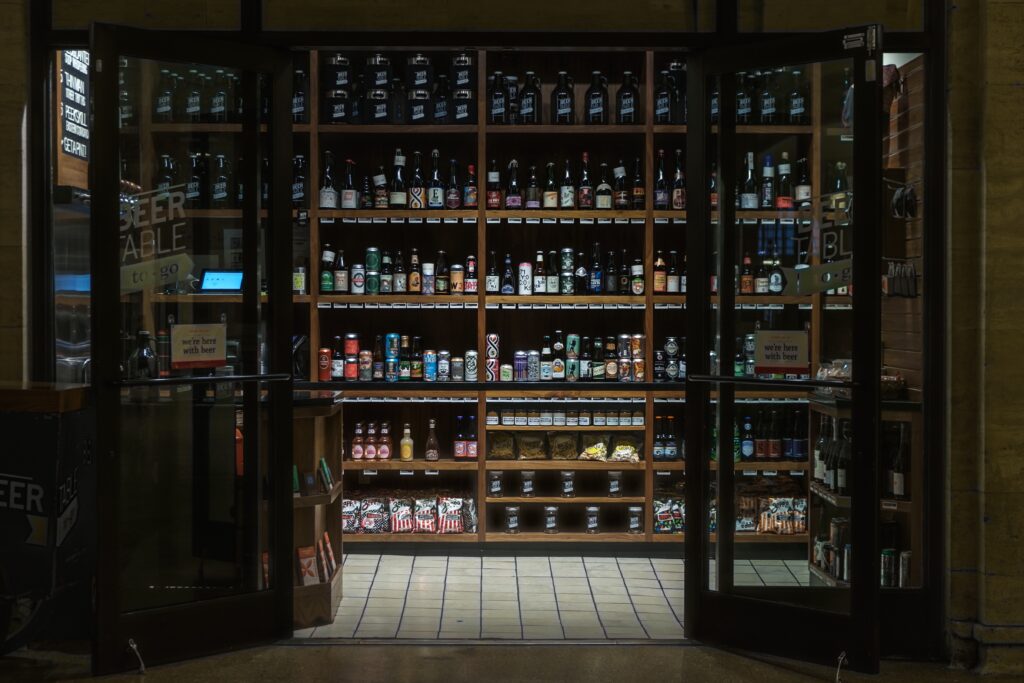Imagine you’ve just purchased a shiny new wine fridge to house your beloved collection. But as you attempt to maneuver the fridge into its designated spot, a nagging question arises: is it safe to lay a wine fridge on its side? This article will address this common concern and provide you with the knowledge you need to ensure the safety of your wine fridge during transportation and installation. So, before you start rearranging your space, let’s find out if laying a wine fridge on its side is a risky move or a perfectly acceptable option.
Understanding the Structure of a Wine Fridge
When it comes to understanding the structure of a wine fridge, it is important to know the components that make up this essential appliance and the functionality of each of these components.
Components of a Wine Fridge
A wine fridge typically consists of several key components that work together to create the optimal storage conditions for your beloved bottles of wine. These components include:
-
Compressor: The compressor is the heart of the wine fridge. It is responsible for circulating the refrigerant and regulating the temperature inside the appliance.
-
Evaporator: The evaporator helps cool the air within the wine fridge by removing heat through the process of evaporation.
-
Condenser: The condenser, on the other hand, helps release the heat absorbed by the refrigerant, ensuring that the temperature inside the wine fridge remains consistent.
-
Thermostat: The thermostat acts as the control center, allowing you to set and adjust the desired temperature inside the wine fridge.
-
Insulation: Proper insulation is crucial in retaining the cool air within the appliance, preventing temperature fluctuations and maintaining an ideal storage environment for your wines.
Functionality of Each Component
Now that we have a basic understanding of the components that make up a wine fridge, let’s take a closer look at the functionality of each component:
-
Compressor: The compressor plays a vital role in the wine fridge’s operation. It compresses the refrigerant, increasing its pressure and temperature, before circulating it through the system.
-
Evaporator: The evaporator is responsible for absorbing heat from the air inside the wine fridge, cooling it down, and maintaining the desired temperature.
-
Condenser: As the refrigerant absorbs heat from the air inside the wine fridge, it becomes hot. The condenser’s primary function is to release this heat, maintaining the temperature balance within the appliance.
-
Thermostat: The thermostat allows you to set the desired temperature for your wine fridge. It monitors the current temperature and signals the compressor to turn on or off accordingly, ensuring a consistent climate for your wines.
-
Insulation: Proper insulation prevents outside air from infiltrating the wine fridge, minimizing temperature fluctuations and maintaining a stable environment that protects the quality of your wines.
Understanding the functionality of each component allows you to appreciate the delicate balance required for a wine fridge to operate effectively and maintain the ideal storage conditions for your wine collection.
Effects of Laying a Wine Fridge on Its Side
Laying a wine fridge on its side may seem like a convenient option when moving or transporting the appliance, but it can have detrimental effects on its performance and overall longevity. Let’s explore some of the potential consequences of laying a wine fridge on its side.
Damage to the Compressor
The compressor, being a crucial component of the wine fridge, is highly sensitive to improper positioning. When a wine fridge is laid on its side, the lubricating oil inside the compressor can seep out, causing damage to the internal mechanisms. This can lead to decreased efficiency and even complete compressor failure.
Risk of Leaked Coolant
Another significant concern when laying a wine fridge on its side is the risk of coolant leakage. The coolant is a vital substance responsible for cooling the air inside the appliance. When the fridge is tilted, the coolant can escape from its designated system, resulting in potential damage and decreased cooling efficiency.
Impacted Cooling Efficiency
Laying a wine fridge on its side can disrupt the normal flow of the refrigerant, hampering its ability to effectively cool the air inside the appliance. This can lead to uneven temperatures, fluctuations, and overall compromised cooling efficiency.
To ensure the optimal performance and longevity of your wine fridge, it is crucial to avoid laying it on its side whenever possible. Taking precautions when moving or transporting the appliance can help prevent these potential issues and keep your wine collection safe.

Considering the Compressor While Moving a Wine Fridge
When planning to move a wine fridge, it is essential to consider the compressor’s vulnerability to movement and positioning. Understanding the purpose of the compressor and the hazards it may face when the fridge is positioned on its side is crucial for proper handling.
Purpose of the Compressor
The compressor is the heart of the wine fridge, responsible for regulating the temperature and creating the ideal storage environment for your wines. It works by compressing the refrigerant, increasing its pressure and temperature, and circulates it throughout the system. Without a functioning compressor, the wine fridge cannot maintain the desired temperature and may fail to properly cool your wines.
Potential Hazards to the Compressor When the Fridge is Positioned on Its Side
Positioning a wine fridge on its side exposes the compressor to various hazards that can compromise its functionality:
-
Loss of Lubricant: When the wine fridge is tilted on its side, the lubricating oil inside the compressor may leak out. This loss of crucial lubrication can lead to increased friction and wear on the compressor’s internal components, eventually resulting in decreased efficiency and potential failure.
-
Oil Migration: In addition to lubricating the compressor, the oil also helps seal the refrigerant to prevent leakage. When the fridge is laid on its side, the oil can migrate into the refrigerant lines, hindering proper circulation and potentially causing blockages.
By understanding the vulnerabilities of the compressor and the risks associated with improper positioning, you can take the necessary precautions to protect this vital component when moving your wine fridge.
Proper Ways to Transport a Wine Fridge
Transporting a wine fridge requires careful consideration to prevent damage to the appliance and ensure its continued functionality. It is advisable to follow professional transport recommendations or take necessary precautions on your own if you decide to move the appliance.
Professional Transport Recommendations
If possible, hiring professional movers or appliance transport specialists is the best way to ensure the safe transportation of your wine fridge. These professionals have the knowledge and expertise to handle the appliance correctly, minimizing the risk of damage to both the wine fridge and its components.
Professional transport recommendations may include:
-
Consultation: Seek advice from professional movers or appliance transport specialists to understand the best practices for moving your specific wine fridge model.
-
Secure Packaging: Professional movers often use specialized packaging materials and techniques to secure the wine fridge during transport, minimizing the risk of damage due to movement.
-
Specialized Equipment: Professionals may utilize specialized equipment, such as dollies or moving straps, to safely and efficiently move the wine fridge without putting excessive stress on its components.
Precautions When Moving the Appliance on Your Own
If hiring professional movers is not feasible, you can still take precautions to minimize the risk of damage while moving the wine fridge yourself:
-
Empty the Fridge: Remove all the bottles and shelves from the wine fridge before transport. This reduces the weight and minimizes the risk of items shifting and causing damage during the move.
-
Secure the Doors: Ensure that the doors of the wine fridge are securely closed and locked before moving. This prevents them from swinging open, potentially damaging the appliance or surrounding objects.
-
Use Proper Handling Techniques: When moving the wine fridge, avoid tilting it on its side as much as possible. Instead, opt for rolling or sliding the appliance, taking care to avoid sudden movements or impacts.
By following professional transport recommendations or taking necessary precautions during a DIY move, you can minimize the risk of damage to your wine fridge and enjoy a fully functional appliance once it reaches its new location.

Positioning a Wine Fridge
Choosing the ideal location and positioning for your wine fridge is crucial for maintaining its optimal performance and ensuring a favorable storage environment for your wines. Let’s explore the factors to consider when positioning your wine fridge and the benefits of upright positioning.
Ideal Location for a Wine Fridge
When selecting the location for your wine fridge, consider the following factors:
-
Stability: Choose a stable and level surface to position your wine fridge. This helps prevent any unnecessary vibrations or movements that can disturb the sediment in your wine bottles.
-
Temperature Stability: Ideally, the location should have a consistent temperature, away from direct sunlight, heat sources, or extreme temperature fluctuations. This ensures that the wine fridge can efficiently maintain the desired temperature range.
-
Ventilation: Wine fridges require proper ventilation to dissipate heat and maintain cooling efficiency. Ensure that there is sufficient space around the appliance, allowing for proper airflow and preventing the buildup of excess heat.
Benefits of Upright Positioning
By placing your wine fridge in an upright position, you can enjoy several benefits:
-
Efficient Cooling: Upright positioning allows the refrigerant to flow naturally through the appliance, optimizing cooling efficiency and ensuring even temperature distribution inside the wine fridge.
-
Reduced Risk of Damage: Properly positioning the wine fridge prevents the compressor from being strained or damaged. It also minimizes the risk of leaked coolant, preserving the overall functionality and longevity of the appliance.
-
Easy Access: An upright wine fridge allows for convenient access to your wine collection. It eliminates the need to reach or bend down, making it easier to view and select bottles without disturbing other wines.
By taking into account the ideal location and positioning for your wine fridge – including stability, temperature stability, and ventilation – and opting for an upright orientation, you create a favorable environment for your wines while ensuring the longevity of your appliance.
Understanding the Role of Coolant
Coolant plays a crucial role in the operation of a wine fridge, as it is responsible for effectively cooling the air inside the appliance. Understanding the use of coolant and why leaking coolant is a risk is important in maintaining the proper functionality of your wine fridge.
Use of Coolant in a Wine Fridge
Coolant, also known as refrigerant, is a specialized substance used in the cooling system of a wine fridge. Its primary function is to absorb heat from the air inside the appliance, lowering its temperature and maintaining the desired climate for your wines.
The coolant circulates through the system, transitioning between liquid and gaseous states as it absorbs and releases heat. This continuous cycle ensures that the wine fridge remains at the set temperature, creating an ideal storage environment.
Why Leaking Coolant is a Risk
When a wine fridge is laid on its side or subjected to rough handling during transportation, there is a risk of coolant leakage. This can have several adverse effects:
-
Decreased Cooling Efficiency: Leaked coolant disrupts the normal flow and balance within the cooling system, leading to decreased cooling efficiency. As a result, the wine fridge may struggle to maintain the desired temperature range, potentially impacting the quality and longevity of your wines.
-
Environmental Impact: Coolants used in refrigeration systems often contain environmentally harmful substances, such as chlorofluorocarbons (CFCs) or hydrochlorofluorocarbons (HCFCs). Leaking coolant releases these substances into the environment, contributing to ozone depletion and climate change.
-
Health and Safety Concerns: In the event of coolant leakage, there may be potential health and safety risks associated with exposure to the released substances. It is important to handle any leaked coolant with caution and seek professional assistance for cleanup and repairs.
By understanding the role of coolant in a wine fridge and the risks associated with leaking coolant, you can take the necessary precautions to prevent damage to your appliance and minimize the impact on the environment and your well-being.

Preventing Damage to Wine Fridge During Repositioning
When repositioning a wine fridge, it is crucial to take appropriate steps to prevent damage to the appliance and ensure its continued functionality. By following a few simple guidelines before and during the repositioning process, you can mitigate potential risks and keep your wine fridge in optimal condition.
Steps to Take Before Moving Your Wine Fridge
Before repositioning your wine fridge, consider the following steps to minimize the risk of damage:
-
Plan Ahead: Carefully assess the new location and ensure it meets the necessary requirements for stability, temperature stability, and ventilation. This will help you avoid continuously moving the appliance and potentially causing unnecessary strain on its components.
-
Empty the Fridge: Remove all the bottles and shelves from the wine fridge and pack them securely to prevent breakage. This reduces the weight of the appliance, making it easier to handle and minimizing the risk of items shifting during the move.
-
Secure Doors and Shelves: Ensure that the doors and shelves are properly secured within the wine fridge. Use tape or straps to secure them in place, preventing them from swinging open or moving while being transported.
-
Defrost If Necessary: If your wine fridge has a manual defrosting function, ensure that it is defrosted and dry before moving. This prevents water leakage during the move and potential damage to the appliance.
What to Do If the Fridge Has Been Laid on Its Side
In the unfortunate event that your wine fridge has been laid on its side during repositioning, it is important to take immediate action to minimize any potential damage:
-
Stand Upright: If the wine fridge has been laid on its side for an extended period, stand it upright and let it rest in its proper position for at least 24 hours. This allows any oil or refrigerant that may have leaked to settle back in the appropriate compartments.
-
Check for Leaks: Inspect the wine fridge for any signs of coolant leakage. If you notice any, consult a professional technician to assess the extent of the damage and perform any necessary repairs.
-
Monitor Performance: After repositioning the wine fridge, closely monitor its performance for any irregularities or changes in cooling efficiency. If you notice any issues, contact a professional technician for further evaluation and assistance.
By following these steps and promptly addressing any potential issues, you can prevent further damage to your wine fridge and ensure its continued functionality after repositioning.
Recovery Time After Repositioning a Wine Fridge
After repositioning a wine fridge, it is crucial to allow it sufficient recovery time before reusing it. This recovery period ensures that the appliance can stabilize and resume its normal functionality, minimizing the risk of damage or compromised cooling efficiency.
How Long to Wait Before Reusing the Fridge
To ensure proper recovery and allow your wine fridge to stabilize, it is recommended to wait at least 24 hours before reconnecting and using the appliance. This timeframe allows any internal components that may have been affected during the repositioning to settle back into their proper positions and ensures optimal performance.
During this recovery period, it is important to keep the wine fridge plugged in and powered on, allowing it to gradually reach the desired temperature. Avoid opening the doors excessively, as this can cause temperature fluctuations and interrupt the recovery process.
Signs Your Wine Fridge is Functioning Normally After Repositioning
After the recovery period, monitor your wine fridge for the following signs, which indicate that it is functioning normally:
-
Consistent Temperature: Check that the wine fridge maintains a consistent temperature within the desired range. Use a reliable thermometer to verify the accuracy of the temperature settings.
-
Proper Humidity Levels: A functioning wine fridge should maintain adequate humidity levels to preserve the integrity and quality of your wine collection. Ensure that the humidity controls are working correctly and adjust them as necessary.
-
Even Cooling: The wine fridge should evenly cool the entire storage space, preventing any noticeable temperature variations between different sections or shelves.
-
Quiet Operation: Normal operation of a wine fridge should be relatively quiet. Any unusual or excessive noise may indicate a problem with the appliance and should be addressed by a professional technician.
If you notice any significant deviations from normal functionality after the recovery period, such as fluctuating temperatures, excessive noise, or visible signs of damage, it is advisable to contact a professional technician for further assessment and necessary repairs.
By allowing sufficient recovery time and monitoring your wine fridge for signs of normal functionality, you can ensure that it continues to operate at optimal performance and provides the ideal storage environment for your wine collection.
